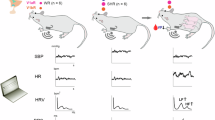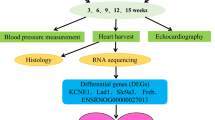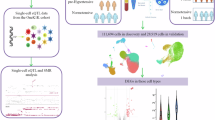Abstract
Previous studies in our laboratory have demonstrated that the thermosensitivity locus cosegregates with blood pressure and that the elevated expression and restriction fragment length polymorphism of HSP70 gene are associated with hypertension. Cell protection against environmental stressors such as heat and chemicals is often accompanied by up-regulated expression of a wide spectrum of heat shock genes(HSP). To further investigate the interrelation between HSP expression and blood pressure regulation, we employed an effective method of cloning 2 potential hypertension-related HSPs. Synthetic oligonucleotides corresponding either to a highly-conserved region of the known HSP family or a repetitive sequence in the protein encoding gene were used as target primers for polymerase chain reaction (PCR). cDNA prepared from heat-stressed and non-stressed vascular smooth muscle cells (VSMC) of Brown Norway rats (BN.lx) and spontaneously hypertensive rats (SHRp) respectively served as template in the reaction. The PCR products were subsequently analyzed in a single-stranded conformational polymorphism (SSCP) electrophoresing system. Differential gene expression in BN. lx and SHRp was seen on autoradiographs of SSCP gel by comparing the migration patterns of PCR-amplified DNA fragments. Using this technique, we also found that HSP27 and a new member of the large HSP gene family were differentially expressed in BN.1x and SHRp VSMC.
Similar content being viewed by others
Log in or create a free account to read this content
Gain free access to this article, as well as selected content from this journal and more on nature.com
or
References
Peach MJ . Renin-angiotensin system: biochemistry and mechanisms of action. Physiol Rev 1977; 57:313–70.
Campbell DJ . Circulating and tissue angiotensin systems. J Clin Invest 1987; 79:1–6.
Mullins J J, Peters J, Ganten D . Fulminant hypertension in transgenic rats haxbouring the mouse Ren-2 gene. Nature 1990; 344:541–4.
Caulfield M, Lavender P, Farrall M, et al. Linkage of the angiotensinogen gene to essential hypertension. N Engl J Med 1994; 330:1629–33.
Deng Y, Rapp JP . Cosegregation of blood pressure with angiotensin converting enzyme and atrial natriuretic peptide receptor genes using Dahl salt-sensitive rats. Nature Gen 1992; 1:267–72.
Tremblay J, Huot C, Willenbrock RC, et al. Increased cyclic guanosine monophosphate pro-duction and over expression of atrial natriuretic peptide A-receptor mRNA in spontaneously hypertensive rats. J Clin Invest 1993; 92:2499–508.
Benishin CG, Lewanczuk RZ, Pang PKT . Purification of parathyroid hypertensive factor from palsma of spontaneously hypertensive rats. Proc Natl Acad Sci USA 1991; 88:6372–6.
Harrap SB, Davidson HR, Connor JM, et al. The angiotensin I converting enzyme gene and predisposition to high blood pressure. Hypertension 1993; 21:455–60.
Jeunemaitre X, Lifton RR, Hunt SC, Williams RR, Lalouel JM . Absence of linkage between the angiotensin converting enzyme locus and human essentail hypertension. Nature Gen 1992;1:72–5.
Hilbert P, Lindpaintner K, Beckmann JS, et ah Chromosomal mapping of two genetic loci associated with blood-pressure regulation in hereditary hypertensive rats. Nature 1991; 353:521–9.
Jacob HJ, Lindpainter K, Lincoln SE, et al. Genetic mapping of a gene causing hypertension in the stroke-prone spontaneously hypertensive rat. Cell 1991; 67:213–24.
Lifton RP, Dluhy RG, Powers M, et al. A chimaeric 11β-hydroxylase/aldosterone synthasegene causes glucocorticoid-remediable aldosteronism and human hypertension. Nature 1992;355:262–5.
Lifton RP, Hunt SC, Willams RR, Pouyssegur J, Lalouel JM . Exclusion of the Na+-H+ antiporter as a candidate gene in human essential hypertension. Hypertension 1991; 17:8–14.
Malo D, Schlager G, Tremblay J, Hamet P . Thermosensitivity, a possible new locus involved in genetic hypertension. Hypertension 1989; 14:121–8.
Hamet P, Malo D, Tremblay J . Increased transcription of a major stress gene in spontaneously hypertensive mice. Hypertension 1990; 15:904–8.
Tremblay J, Hadrava V, Kruppa U, Hamet P . Enhanced growth-dependent expression of TGF β 1and hsp70 genes in aortic smooth muscle cells from spontaneously hypertensive rats. Can J physiol Pharmacol 1992; 70:565–72.
Pravenec M, Sun YL, Kunes J, et al. Environmental susceptibility in hypertension: potential role of HSP70 and TNF α genes. J Vasc Med Biol 1991; 3:297–302.
Hamet P, Kong D, Pravenec M, et al. Restriction fragment length polymorphism of hsp70 gene, localized in the RT1 complex, is associated with hypertension in spontaneously hypertensive rats. Hypertension 1992; 19:611–4.
Lindquist S, Craig EA . The heat-shock protein. Annu Rev Genet 1988; 22:631–77.
Ang D, Liberek K, Skowyra D, Zylicz M, Georgopoulos C . Biological role and regulation of the universally conserved heat shock proteins. J Biol Chem 1991; 36: 24233–6.
Pechan PM . Heat shock proteins and cell proliferation. FEBS Lett 1991; 280:1–4.
Young RA . Stress proteins and immunology. Annu Rev Immunol 1990; 8:401–20.
Georgopoulos C . Role of the major heat shock proteins as molecular chaperones. Annu Rev Cell Biol 1993; 9:601–34.
Parsell DA, Lindquist S . The function of heat-shock proteins in stress tolerance: degradation and reactivation of damaged proteins. Annu Rev Genet 1993; 27:437–96.
Lee Y J, Hou ZZ, Curetty L, Corry PM . Expression, synthesis, and phosphorylation of the HSP28 family during development and decay thermotolerance in CHO plateau-phase cells. J Cell Physiol 1992; 150:441–6.
Landry J, Chretien P, Lambert H, Hickey E, Weber LA . Heat shock resistance conferred by expression of the human HSP27 gene in rodent cells. J Cell Biol 1989; 109:7–15.
Li GC, Li L, Liu YK, Mak JY, Chen LL, Lee WMF . Thermal response of rat fibroblasts stably transfected with the human 70-kDa heat shock protein-encoding gene. Proc Natl Acad Sci USA 1991; 88:1681–5.
Sanchez Y, Taulien J, Borkovich KA, Lindquist S . Hspl04 is required for tolerance to many forms of stress. EMBO J 1992; 11:2357–64.
Kunes J, poirier M, Tremblay J, Hamet P . Expression of hsp70 gene in lymphocytes from normotensive and hypertensive humans. Acta physiol Seand 1992; 146:307–11.
Wu DY, Ugozzoli L, Pal BK, Qian J, Wallace B . The effect of temperature and olionucleotide primer length on the specificity and effeciency of amplification by the polymerase chain reaction. DNA Cell Biol 1991; 10:233–8.
Orita M, Suzuki Y, Sekiya T, Hayashi K . Rapid and sensitive detection of point mutations and DNA polymorphisms using the polymerase chain reaction. Genomics 1989; 5:874–9.
Hadrava V, Tremblay J, Hamet P . Abnormalities in growth characteristics of aortic amooth muscle cells in spontaneously hypertensive rats. Hypertension 1989; 13:589–97.
Sun YL, Pao CI, Sen S, Kuo T . High-resolution mapping of DNAase I hypersensitive site in the chichen β-tubulin gene transfected into monkey cells. J Biol Chem 1987; 262:7764–9.
Sambrook J, Fritsch EF, Maniatis T . Molecular cloning: A Laboratory Manual. Cold Spring Harbor: Cold Spring Harbor Laboratory 1989:Ed.2 pp6.53.
Drabent B, Genthe A, Benecke BJ . In vitro transcription of a human hsp70 heat shock gene by extracts prepared from heat-shocked and non-heat-shocked human cells. Nucleic Acids Res 1986; 14:8933–48.
Long OFM, Wang S, Narasimhan P, et al. cDNA cloning and expression of stress-inducible rat hsp70 in normal and injured rat brain. J Neurosci Res 1993; 36:325–35.
Wisniewski J, Kordula T, Krawczyk Z . Isolation and nucleotide sequence analysis of the rat testis-specific major heat-shock protein (HSP70)-related gene. Biochim Biophys Acta 1990; 1048:93–9.
Cellier MF, Teyssier J, Nicolas M, Liautard JP, Marti J, Sri Widada J . Cloning and characterization of the Brucella ovis heat shock protein DnaK functionally expression i n Escherichia coli. J Bacteriol 1992; 174:8036–42.
Voshima K, Handelman B, Cooper LF . Isolateion and characterization of a rat HSP27 gene. Biochem Biophys Res Commun 1993; 197:1388–95.
Glalchenhaus N, Cuzin F . A role for ID repetitive sequences in growth- and transformation- dependent regulation of gené expression in rat fibroblast. Cell 1987; 50:1081–9.
Luo Y, Amin J, Voellmy R . Ecdysterone receptor is a sequence-specific transcription factor involved in the developmental regulation of heat shock genes. Mol Cell Biol 1991; 11:3660–3675.
Michishita M, Satoh M, Yamaguchi M, Hirayoshi K, Okuma M, Nagata K . Phosphorylation of the stress protein HSP27 is an early event in murine myelomonocytic leukemic cell differentiation induced by leukemia inhibitory factor /D-factor. Biochem Biophys Res Commun 1991; 176:979–84.
Marui N, Nishino H, Sakai T, Aoike A, Kawai K, Fukushima M . Delta 12-Prostaglandin J2 mimics heat shock in inducing cell cycle arrest at G1 phase. Biochem Biophys Res Commun 1991; 179:1662–9.
Spector NL, Samson W, Ryan C, et al. Growth arrest of human B lymphocytes is accompanied by induction of the low molecular weight mammalian heat shock protein (Hsp28). J Immunol 1992; 148:1668–73.
Huot J, Roy G, Lambert H, Chretien P, Landry J . Increased survival after treatments with anticancer agents of chinese hamster cells expressing the human Mr 27,000 heat shock protein. Cancer Res 1991; 51:5245–52.
Landry J, Lambert H, Zhou M, et al. Human HSP27 is phosphorylated at serines 78 and 82 by heat shock and mitogen-activated kinases that recognize the same amino acid motif as S6 kinase II. J Biol Chem 1992; 267:794–803.
Zhou M, Lambert H, Landry J . Transient activation of a distinct serine protein kinase is responsible for 27-kDa heat shock protein phosphorylation in mitogen-stimulated and heat-shocked cells. J Biol Chem 1993; 268:35–43.
Mendelsohn ME, Zhu Y, O'Neill S . The 29-kDA proteins phosphorylated in thrombin-activated human platelets are forms of the estrogen receptor-related 27-kDA heat shock protein. Proc Natl Acad Sci USA 1991; 88: 11212–6.
Bitar KN, Kaminski MS, Hailat N, Cease KB, Strahler JR . HSP27 is a mediator of sustained smooth muscle contraction in response to bombesin. Biochem Biophys Res Commun 1991; 181:1192–200.
Arrigo AP . Tumor necrosis factor induces the rapid phosphorylation of the mammalian heat shock protein hsp28. Mol Cell Biol 1990; 10:1276–80.
Welch WJ . Phorbol ester, calcium ionophore, or serum added to quiescent rat embryo fibroblast cells all result in the elevated phosphorylation of two 28,000-Dalton mammalian stress proteins. J Biol Chem 1985;260:3058:62.
Acknowledgements
The authors acknowledge support from MRC Canada (10803) and the Dairy Bureau of Canada. The technical expertise of Carole long, Gilles Corbeil and Régis Tremblay, the secretarial skills of Josée Bédard-Baker and the editorial assistance of Ovid Da Silva are appreciated.
Author information
Authors and Affiliations
Additional information
*This article is dedicated to Dr. Zhen YAO commemorating his 80th birthday
Requests for reprints should be addressed to Dr. Yu Lin SUN, Laboratory of Molecular Medicine, Centre de Recherche Hôtel-Dieu de Montréal, 3850 St. Urbain St, Montréal, Quebec H2W 1T8, Canada.
Rights and permissions
About this article
Cite this article
Sun, Y., Tremblay, J., Kong, D. et al. Candidate genes of hypertension with defective environmental expression. Cell Res 5, 47–58 (1995). https://doi.org/10.1038/cr.1995.5
Received:
Accepted:
Issue date:
DOI: https://doi.org/10.1038/cr.1995.5



